Lyons W.C. (ed.). Standard handbook of petroleum and natural gas engineering.2001- Volume 1
Подождите немного. Документ загружается.


Drilling Bits and Downhole Tools
825
Stabilizer Design.
There are four commonly used stabilizer designs.
Solid-vpe Stabilizers.
(See Figure
4-180.)
These stabilizers have no moving
or
replaceable parts, and consist of mandrel and blades that can be one piece
alloy steel (integral blade stabilizer)
or
blades welded on the mandrel (weld-on
blade stabilizer). The blades can be straight,
or
spiral, and their working surface
is either hardfaced with tungsten carbide inserts
or
diamonds
[57,58].
Repl8Ceable-BladeS Stabilizers.
(See Figure
4-181 [58A].)
These stabilizers can
maintain full gauge stabilization. Their blades can be changed at the rig with
hand tools; no machining
or
welding is required.
Sleeve-vpe Stabilizers.
(See Figure
4-182.)
These stabilizers have replaceable
sleeve that can be changed in the field. There are two types of sleeve-type
stabilizers: the rotating sleeve-type stabilizer (Figure
4-182A [58])
and the
nonrotating sleeve-type stabilizer (Figure
4-182B [59]).
Rotating sleeve-type
stabilizers have no moving parts and work in the same way as solid-type
stabilizers. Nonrotating sleeve-type stabilizers have a nonrotating rubber sleeve
supported by the wall of the borehole. The rubber sleeve stiffens the drill collar
string in packed hole operations just like a bushing.
Reamers.
(See Figure
4-183 [59].)
Reamers are stabilizers with cutting elements
embedded in their fins, and are used
to
maintain hole gage and drill out doglegs
and keyseats in hard formations. Because of the cutting ability of the reamer,
the bit performs less work on maintaining hole gauge and more work on drilling
A
8
Integral Blade Weld-On Blade
C
D
Big BearTM Near-Bit Diamond Near-Bit
Stabilizer. Hardfacing Stabilizer.
Alloy
steel Stabilizer. Granular Stabilizer
with tungsten carbide hardfacing. (Servco) tungsten carbide (Christensen)
Figure
4-1
80.
Solid-type stabilizers.
(Courtesy
Smith
lnternafional
and
Baken
Hughes
INTEC?)
compacts. (Servco) hardfacing. (Servco)
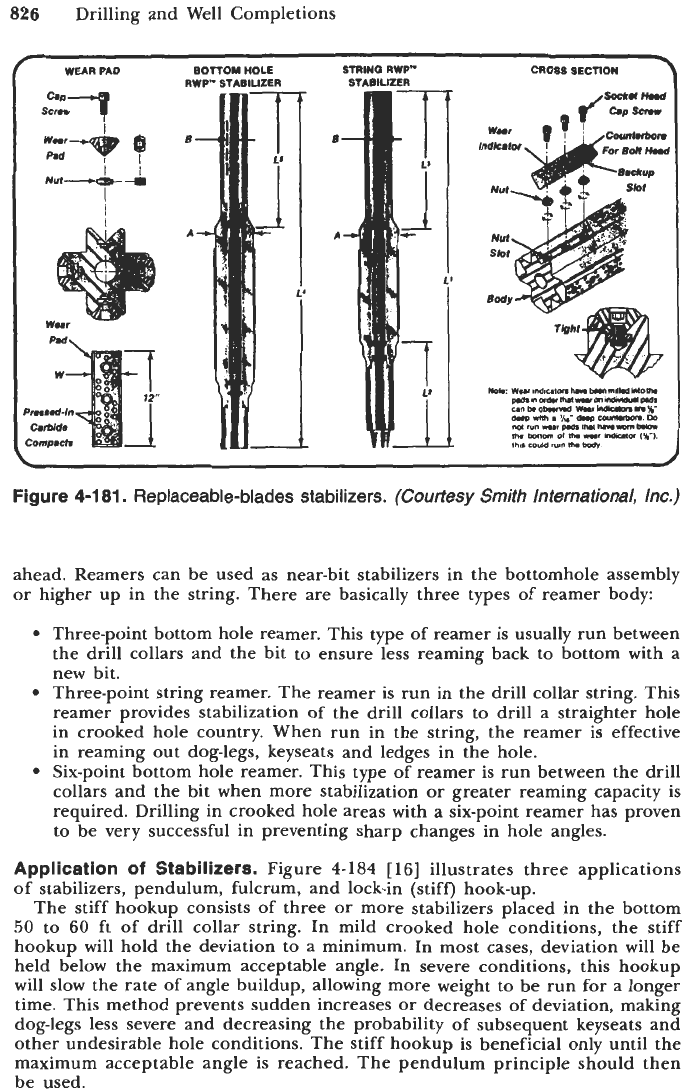
826
Drilling and Well Completions
WEAR PAD
BOTTOM
HOLE
RWP" STABILIZER
L4
A
Figure
4-1
81.
Replaceable-blades stabilizers.
(Courtesy
Smith International, Inc.)
ahead. Reamers can be used as near-bit stabilizers in the bottomhole assembly
or higher up in the string. There are basically three types of reamer body:
Three-point bottom hole reamer. This type of reamer is usually run between
the drill collars and the bit to ensure less reaming back to bottom with a
new bit.
Three-point string reamer. The reamer is run in the drill collar string. This
reamer provides stabilization of the drill collars to drill a straighter hole
in crooked hole country. When run in the string, the reamer is effective
in reaming out dog-legs, keyseats and ledges in the hole.
Six-point bottom hole reamer. This type of reamer is run between the drill
collars and the bit when more stabilization or greater reaming capacity is
required. Drilling in crooked hole areas with a six-point reamer has proven
to be very successful in preventing sharp changes in hole angles.
Application
of
Stabilizers.
Figure
4-184
[
161
illustrates three applications
of stabilizers, pendulum, fulcrum, and lock-in (stiffl hook-up.
The stiff hookup consists
of
three or more stabilizers placed in the bottom
50
to
60
ft of drill collar string. In mild crooked hole conditions, the stiff
hookup will hold the deviation
to
a minimum. In most cases, deviation will be
held below the maximum acceptable angle. In severe conditions, this hookup
will slow the rate of angle buildup, allowing more weight to be run for a longer
time. This method prevents sudden increases or decreases of deviation, making
dog-legs less severe and decreasing the probability of subsequent keyseats and
other undesirable hole conditions. The stiff hookup is beneficial only until the
maximum acceptable angle is reached. The pendulum principle should then
be used.
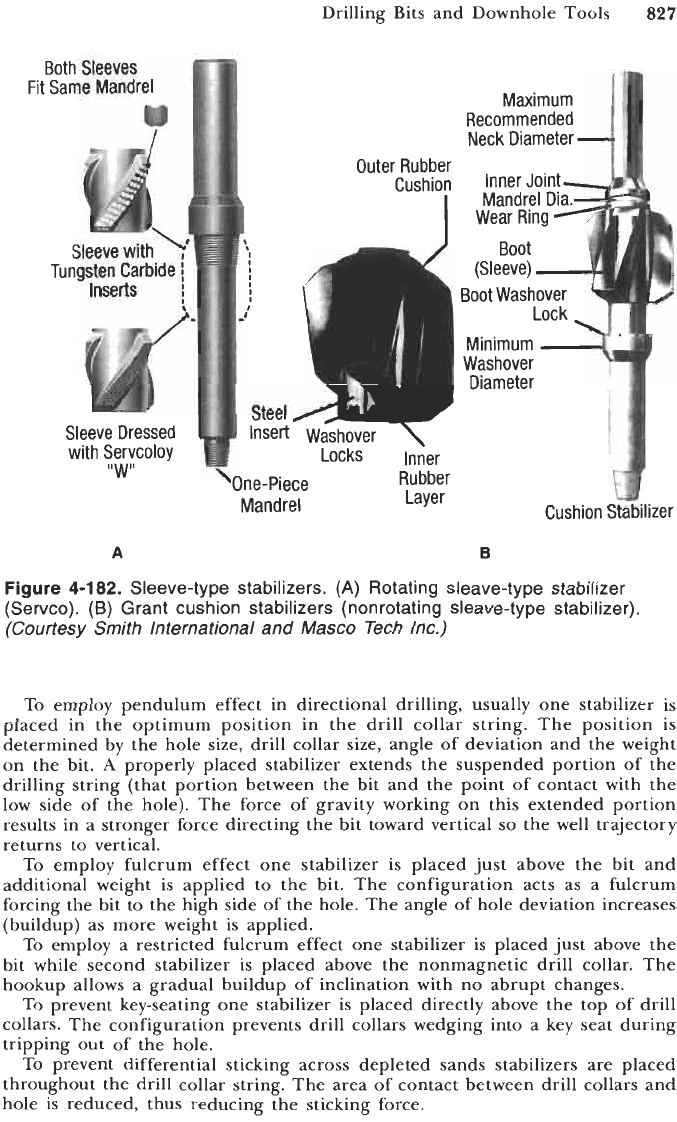
Drilling Bits and Downhole Tools
827
Outer Rubber
Cushion
Cushion Stabilizer
A
B
Figure
4-1
82.
Sleeve-type stabilizers.
(A)
Rotating sleave-type stabilizer
(Servco). (B) Grant cushion stabilizers (nonrotating sleave-type stabilizer).
(Courtesy
Smith
International and Masco
Tech
Inc.)
To employ pendulum effect in directional drilling, usually one stabilizer is
placed in the optimum position in the drill collar string. The position is
determined by the hole size, drill collar size, angle of deviation and the weight
on the bit.
A
properly placed stabilizer extends the suspended portion of the
drilling string (that portion between the bit and the point of contact with the
low side of the hole). The force of gravity working on this extended portion
results in a stronger force directing the bit toward vertical
so
the well trajectory
returns to vertical.
To employ fulcrum effect one stabilizer is placed just above the bit and
additional weight is applied to the bit. The configuration acts as a fulcrum
forcing the bit to the high side of the hole. The angle of hole deviation increases
(buildup) as more weight is applied.
To employ a restricted fulcrum effect one stabilizer is placed just above the
bit while second stabilizer is placed above the nonmagnetic drill collar. The
hookup allows a gradual buildup of inclination with no abrupt changes.
To prevent key-seating one stabilizer is placed directly above the top of drill
collars. The configuration prevents drill collars wedging into a key seat during
tripping out of the hole.
To prevent differential sticking across depleted sands stabilizers are placed
throughout the drill collar string. The area of contact between drill collars and
hole is reduced, thus reducing the sticking force.

8.28
Drilling
and
Well Completions
Figure 4-1 83. Stabilizerheamers; various cutters and schematics
of
cutter
assembly.
(Courtesy Masco Tech Inc.)
Figure 4-184. Applications
of
stabilizers in directional drilling
[16].
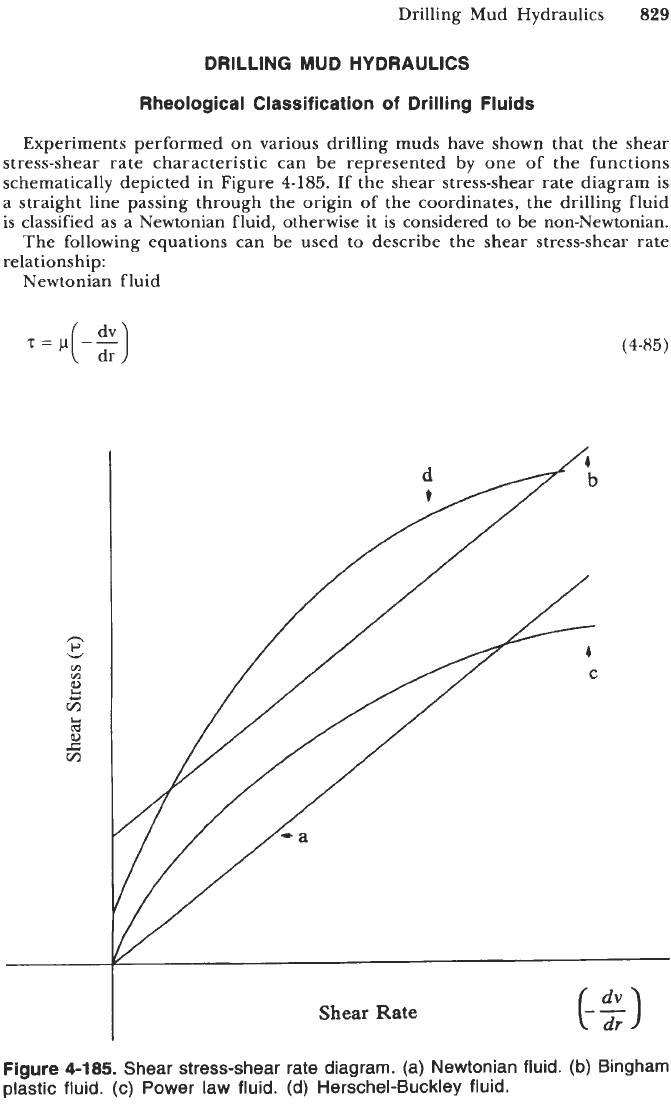
Drilling Mud Hydraulics
829
DRILLING MUD HYDRAULICS
Rheological Classification of Drilling Fluids
Experiments performed on various drilling muds have shown that the shear
stress-shear rate characteristic can be represented by one of the functions
schematically depicted in Figure
4-185.
If the shear stress-shear rate diagram is
a straight line passing through the origin of the coordinates, the drilling fluid
is
classified as a Newtonian fluid, otherwise
it
is
considered to be non-Newtonian.
The
following equations can be used to describe the shear stress-shear rate
relationship:
Newtonian fluid
=
P(-z)
dv
(4-85)
Shear
Rate
Figure
4-185.
Shear stress-shear rate diagram. (a) Newtonian fluid.
(b)
Bingham
plastic fluid. (c) Power law fluid. (d) Herschel-Buckley fluid.
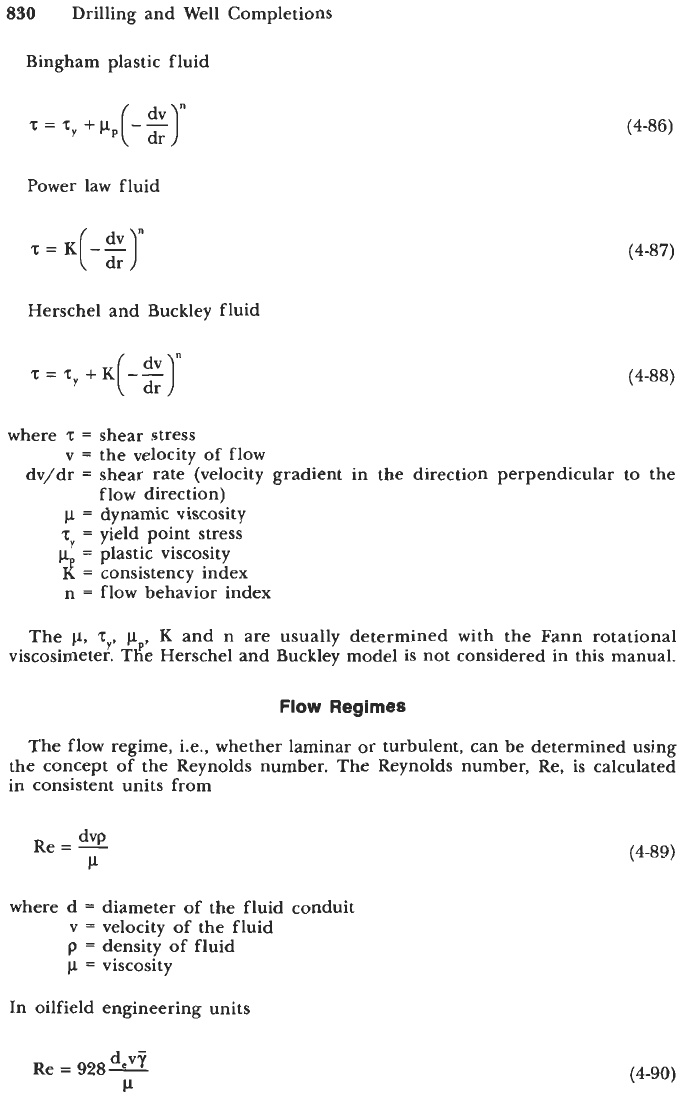
830
Drilling and Well Completions
Bingham plastic fluid
z
=
2,
...(-E)"
Power law fluid
z
=
IC(-$)"
Herschel and Buckley fluid
z
=
2,
+I+$)"
(4-86)
(4-87)
(4-88)
where
T
=
shear stress
v
=
the velocity
of
flow
flow
direction)
dv/dr
=
shear rate (velocity gradient in the direction perpendicular to the
p
=
dynamic viscosity
zy
=
yield point stress
kp
=
plastic viscosity
K
=
consistency index
n
=
flow behavior index
The
k,
zY,
pp,
K
and n are usually determined with the Fann rotational
viscosimeter. The Herschel and Buckley model is not considered in this manual.
Flow
Regimes
The flow regime, Le., whether laminar
or
turbulent, can be determined using
the concept of the Reynolds number. The Reynolds number, Re, is calculated
in consistent units from
dvp
P
Re
=
-
where
d
=
diameter
of
the fluid conduit
v
=
velocity of the fluid
p
=
density
of
fluid
p
=
viscosity
In oilfield engineering units
(4-89)
d,vV
Re
=
928-
P
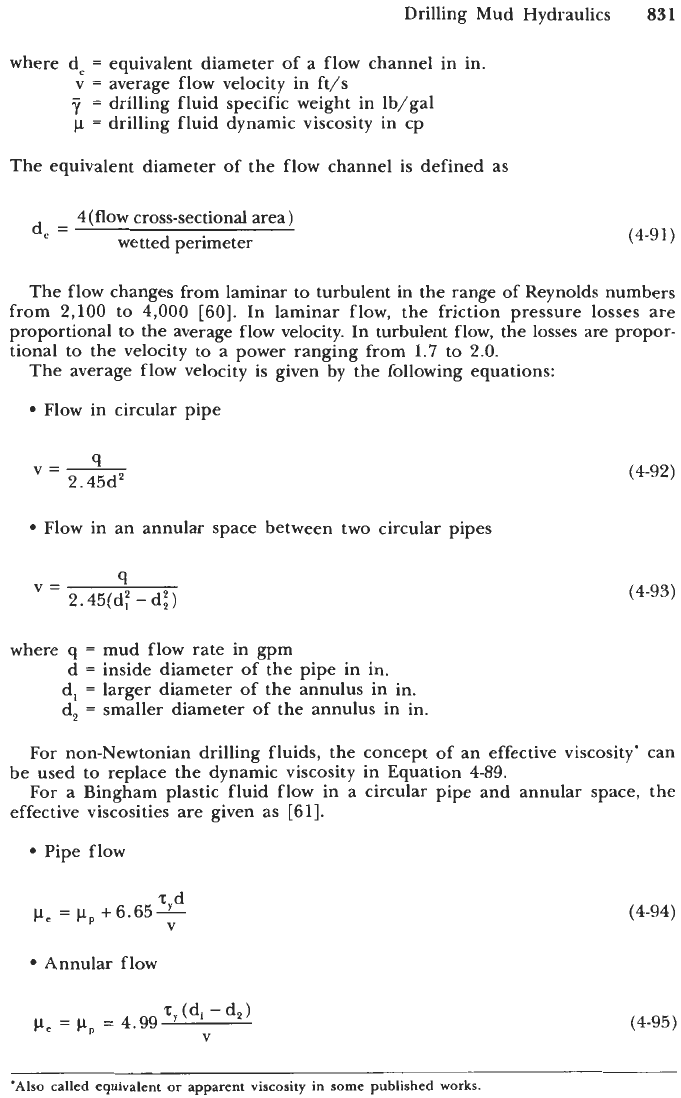
Drilling Mud Hydraulics
where de
=
equivalent diameter of a flow channel in in.
v
=
average flow velocity in ft/s
7
=
drilling fluid specific weight in lb/gal
p
=
drilling fluid dynamic viscosity in cp
The equivalent diameter of the flow channel is defined as
4 (flow cross-sectional area)
wetted perimeter
de
=
83
1
(4-91)
The flow changes from laminar to turbulent in the range of Reynolds numbers
from 2,100 to 4,000 [60]. In laminar flow, the friction pressure losses are
proportional to the average flow velocity. In turbulent flow, the losses are propor-
tional to the velocity to a power ranging from
1.7
to 2.0.
The average flow velocity is given by the following equations:
Flow in circular pipe
Flow in an annular space between two circular pipes
q
2.45(d: -di)
v=
(4-92)
(4-93)
where q
=
mud flow rate in gpm
d
=
inside diameter of the pipe in in.
d,
=
larger diameter of the annulus in in.
d,
=
smaller diameter of the annulus in in.
For non-Newtonian drilling fluids, the concept of an effective viscosity' can
For a Bingham plastic fluid flow in a circular pipe and annular space, the
be used to replace the dynamic viscosity in Equation 4-89.
effective viscosities are given as
[61].
Pipe flow
zd
pe
=
pp
+6.651
V
Annular flow
(4-94)
(4-95)
~~
'Also
called equivalent
or
apparent viscosity in some published
works.
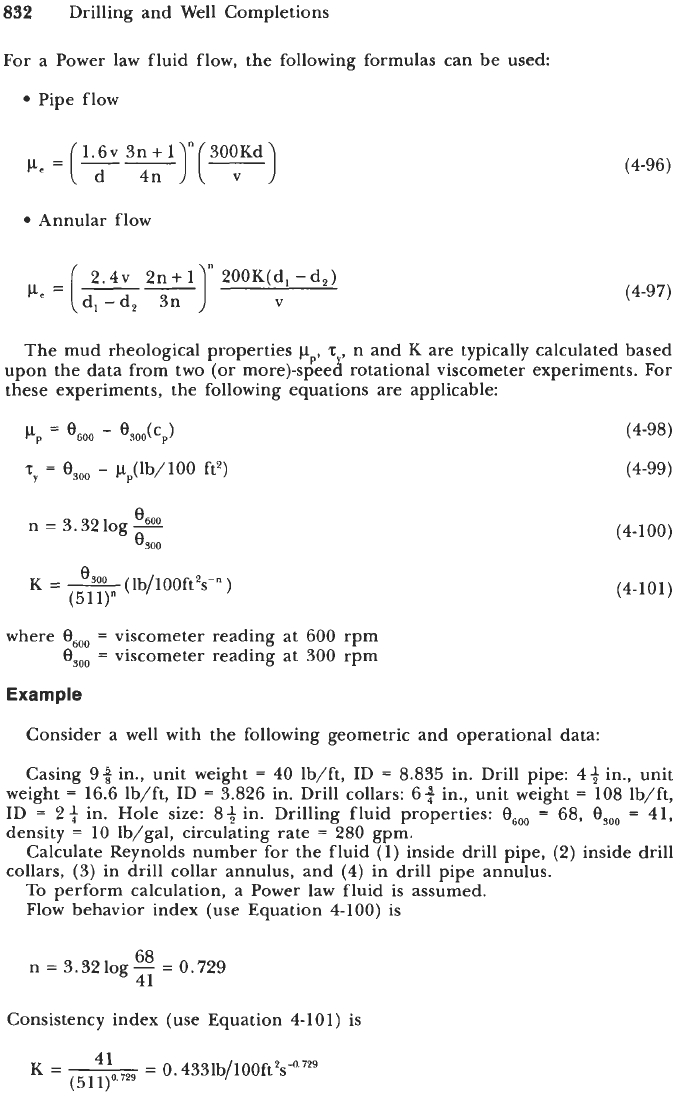
832
Drilling and Well Completions
For a Power law fluid flow, the following formulas can be used:
Pipe flow
(1.6~ 3n
+
1)"
(30y)
pL,=
d4n
-
Annular flow
2.4~ 2n+l 200K(d,
-d2)
pe=(d,-d,sn)'
v
(4-96)
(4-97)
The mud rheological properties
pLp,
z
,
n and
K
are typically calculated based
upon the data from two
(or
more)-speed rotational viscometer experiments. For
these experiments, the following equations are applicable:
PLp
=
e,,,
-
%oo(cp)
zY
=
8,,,
-
pp(lb/lOO ft')
e600
n
=
3.32 log
-
K
=
(
lb/10Oft2s-"
)
e,,,
(511)"
(4-98)
(4-99)
(4-1
00)
(4-101)
where
e,,,
=
viscometer reading at 600 rpm
B,,,
=
viscometer reading at 300 rpm
Example
Consider a well with the following geometric and operational data:
Casing 9Q in., unit weight
=
40 lb/ft, ID
=
8.835
in. Drill pipe: 44 in., unit
weight
=
16.6 lb/ft, ID
=
3.826 in. Drill collars: 6$ in., unit weight
=
108 lb/ft,
ID
=
23
in. Hole size:
8+
in. Drilling fluid properties:
O,,,
=
68,
8,,,
=
41,
density
=
10 lb/gal, circulating rate
=
280
gpm.
Calculate Reynolds number for the fluid
(1)
inside drill pipe,
(2)
inside drill
collars,
(3)
in drill collar annulus, and
(4)
in drill pipe annulus.
To perform calculation, a Power law fluid is assumed.
Flow behavior index (use Equation 4-100) is
68
41
n
=
3.32log-
=
0.729
Consistency index (use Equation 4-101) is
K=--
41
-
0.
4331b/100ft2s".729
(
5
1
1)o.
729
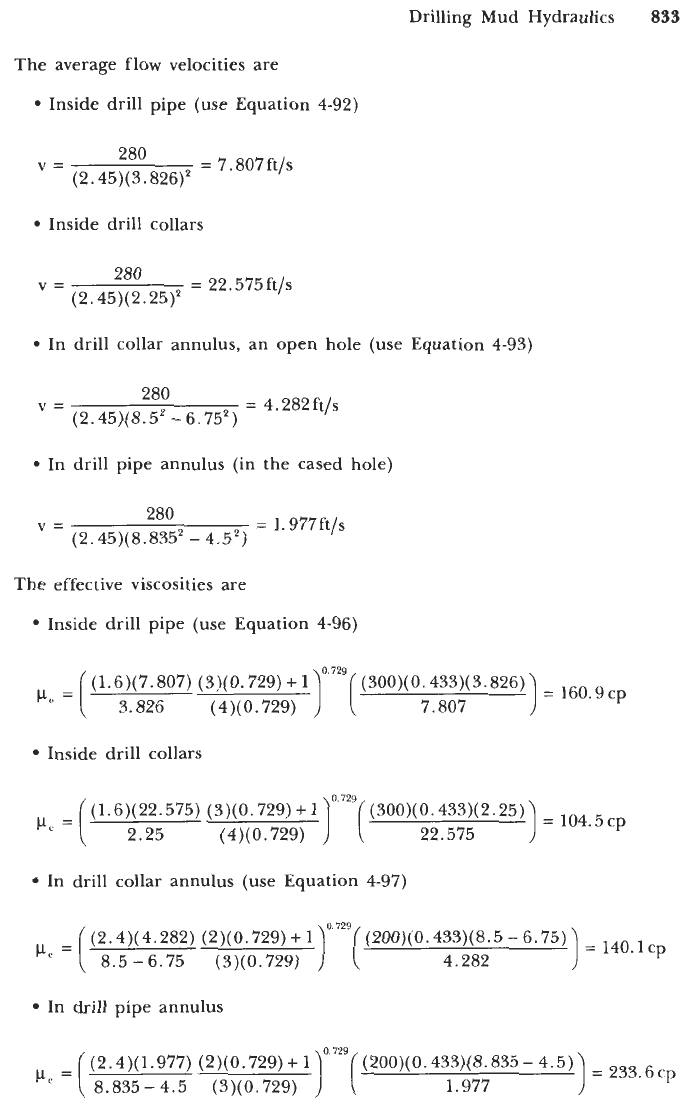
Drilling Mud Hydraulics
833
The average flow velocities are
Inside drill pipe (use Equation 4-92)
=
7.807ft/s
280
(2.45)( 3.826)'
v=
Inside drill collars
v=
280
=
22.575ft/s
(2.45)(2.25)'
In drill collar annulus,
280
v=
(2.45)( 8.5'
-
6.75')
an open hole (use Equation 4-93)
=
4.282ft/s
In drill pipe annulus (in the cased hole)
v=
280
=
1.977ft/s
(2.45)(8.835'
-
4.5')
The effective viscosities are
Inside drill pipe (use Equation 4-96)
Inside drill collars
(1.6)(22.575) (3)(0.729)
+
1
(300)(0.433)(2.25)
"
=(
2.25 (4)(0.729)
729
(
22.575
In drill collar annulus (use Equation 4-97)
(2.4)( 4.282) (2)( 0.729)
+
1
(200)(0.433)( 8.5
-
6.75)
=
140.
cp
Pe
=(
8.5
-
6.75 (3)(0.729) 4.282
1
In drill pipe annulus
(2.4)(1.977) (2)(0.729)+
1
(200)(0.433)(8.835- 4.5)
=
233.6cp
8.835- 4.5 (3)(0.729) 1.977
1
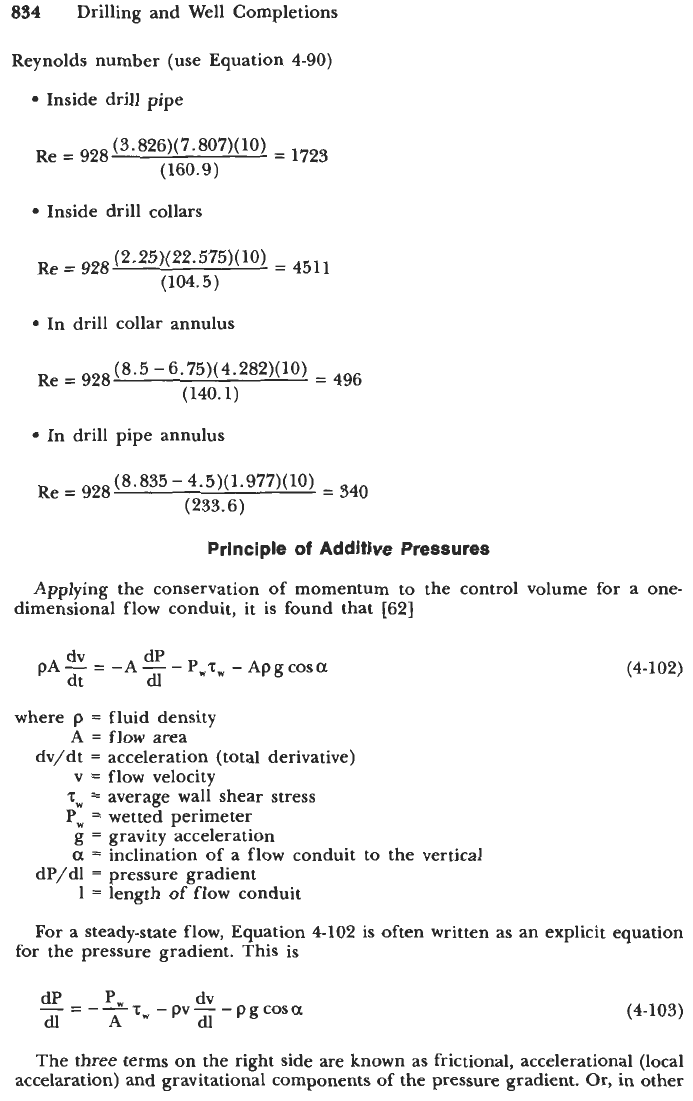
834
Drilling and Well Completions
Reynolds number (use Equation
4-90)
Inside drill pipe
Inside drill collars
In
drill collar annulus
(8.5-6.75)(4.282)(10)
=
496
(140.1)
Re
=
928
In drill pipe annulus
(8.835
-
4.5)( 1.977)(10)
Re
=
928
(233.6)
=
340
Prlnciple
of Additive Pressures
Applying the conservation
of
momentum to the control volume for a one-
dimensional flow conduit, it is found that
[62]
(4-102)
where
p
=
fluid density
A
=
flow area
v
=
flow velocity
dv/dt
=
acceleration (total derivative)
zW
=
average wall shear stress
Pw
=
wetted perimeter
g
=
gravity acceleration
a
=
inclination of a flow conduit
to
the vertical
dP/dl
=
pressure gradient
For
a steady-state flow, Equation
4102
is often written as an explicit equation
1
=
length of flow conduit
for the pressure gradient. This is
dv
dl
A
dl
-
dP
- -
--
Tw
-pv--pgcosa
(4-1 03)
The three terms on the right side are known as frictional, accelerational (local
accelaration) and gravitational components of the pressure gradient.
Or,
in other
